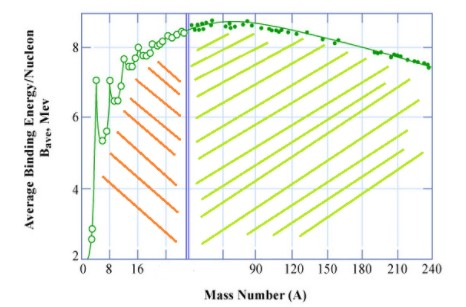
Draw a graph showing the variation of binding energy per nucleon with mass number of different nuclei. Mark the region where the nuclei are (a) most stable, (b) prone to fusion and (c) prone to fission.
Answer
490.5k+ views
Hint: Binding energy is the amount of energy required to disintegrate a system, which means to remove a particle from a system of particles. The amount of energy released during the formation of a nucleus from its component nucleons is known as the nuclear binding energy.
Complete step by step answer:

Greater the nuclear binding energy; more the stability of the resulting nucleus. Conversely, elements with high binding energy are difficult to break up owing to their stability.
The region in blue (roughly including elements from atomic mass 50 to 80) marks the most stable nuclei. It must be noted here that Iron (mass number 56) has the highest binding energy. The region shaded in orange (to the left of the blue region) marks the nuclei that are most prone to fusion. Fusion is generally achieved by combining deuterium and tritium, two isotopes of hydrogen. On the other hand. The region shaded in yellow marks the nuclei most prone to fission. Several heavy elements including uranium, thorium and plutonium undergo spontaneous as well as induced fission.
Note: Binding energy is expressed in MeV per nucleon; the average binding energy being 8MeV if we don’t include the lighter nuclei. Binding energy curve serves two main purposes: it suggests how stable atomic nuclei are and it also suggests possibilities of converting a significant amount of mass into energy.
Complete step by step answer:

Greater the nuclear binding energy; more the stability of the resulting nucleus. Conversely, elements with high binding energy are difficult to break up owing to their stability.
The region in blue (roughly including elements from atomic mass 50 to 80) marks the most stable nuclei. It must be noted here that Iron (mass number 56) has the highest binding energy. The region shaded in orange (to the left of the blue region) marks the nuclei that are most prone to fusion. Fusion is generally achieved by combining deuterium and tritium, two isotopes of hydrogen. On the other hand. The region shaded in yellow marks the nuclei most prone to fission. Several heavy elements including uranium, thorium and plutonium undergo spontaneous as well as induced fission.
Note: Binding energy is expressed in MeV per nucleon; the average binding energy being 8MeV if we don’t include the lighter nuclei. Binding energy curve serves two main purposes: it suggests how stable atomic nuclei are and it also suggests possibilities of converting a significant amount of mass into energy.
Recently Updated Pages
Master Class 12 Economics: Engaging Questions & Answers for Success

Master Class 12 Maths: Engaging Questions & Answers for Success

Master Class 12 Biology: Engaging Questions & Answers for Success

Master Class 12 Physics: Engaging Questions & Answers for Success

Master Class 4 Maths: Engaging Questions & Answers for Success

Master Class 4 English: Engaging Questions & Answers for Success

Trending doubts
Give 10 examples of unisexual and bisexual flowers

Draw a labelled sketch of the human eye class 12 physics CBSE

a Tabulate the differences in the characteristics of class 12 chemistry CBSE

Differentiate between homogeneous and heterogeneous class 12 chemistry CBSE

Why is the cell called the structural and functional class 12 biology CBSE

Differentiate between insitu conservation and exsitu class 12 biology CBSE




